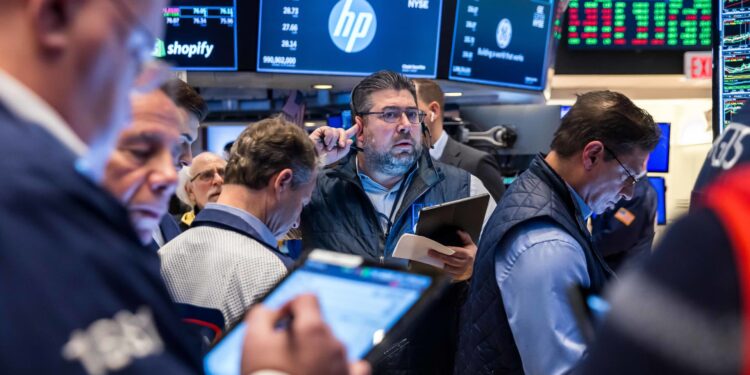[ad_1]
What occurred Friday has some on Wall Road nervous {that a} bigger pullback has begun. Nvidia , the unreal intelligence beneficiary that is lifted markets this yr with its supercharged advance, ended Friday’s session decrease regardless of reaching an all-time excessive earlier within the day. The chipmaker misplaced 5.5% in its worst session since late Might, although, to make certain, Nvidia nonetheless ended the week greater than 6% increased. However some traders are involved markets might be due for a broader unwind with out the assistance from AI names. As it’s, 5 of the Magnificent Seven names dropped final week, excluding Nvidia and Meta Platforms. Apple shares, for instance, slid about 5% on the week. Nvidia, which has added greater than $1 trillion in market worth this yr, is answerable for about 30% of the S & P 500’s combination positive aspects this yr alone, LSEG knowledge exhibits. That advance has helped the S & P 500 climb for 16 out of 19 weeks, notching file after file in its ascent. The broader index is up greater than 7% this yr. “One thing needed to give,” Jonathan Krinsky wrote in a Sunday word. “A consolidation within the AI commerce has been overdue for some time now, so Friday’s key reversal day might sign the beginning of that unwind.” NVDA 5D mountain Nvidia Crowding in AI Certainly, different market observers warned traders the overreliance on AI beneficiaries this yr might imply hazard for the general market. “[If] the market is now counting on Nvidia, AMD and different semi names as the muse now, that may be a far more fragile floor due to the main cyclicality of that enterprise,” wrote Peter Boockvar, chief funding officer at Bleakley Monetary Group. “When it comes to secular growers and linear traits, there was nothing just like the trade creating companies of Google, Apple and for some time Tesla. AI is only a device, not an trade creating one like those right here talked about and semi’s will ALWAYS be a growth and bust enterprise.” In the meantime, Dubravko Lakos-Bujas, chief international fairness strategist at JPMorgan, famous that traders crowding into the few high quality mega-cap tech names with sturdy stability sheets has led to harmful dislocations out there. “Given this relationship coupled with very bullish investor sentiment and positioning, we warning traders that this relationship is prone to work in reverse when the AI euphoria peaks,” he wrote in a Sunday word. “Whereas the bull beta of the market to NVDA is critical (in addition to for META and AMZN), the bear beta of the market to those shares is even stronger ⦠which might pose a better tail danger for the market,” Lakos-Bujas added. Extra proof wanted To make sure, traders might want to see extra proof of a reversal past someday’s buying and selling, BTIG’s Krinsky stated. Wall Road might want to see if this yr’s underperforming sectors can decide up the slack if the mega-cap shares begin to falter, or if the broader market will fall in tandem with this yr’s market leaders. On that entrance, there’s been some excellent news for traders. Notably, the small-cap Russell 2000 outperformed final week, closing it out barely increased, whereas the S & P 500 posted losses, signaling that positive aspects might be extending throughout the asset universe. On Monday, nevertheless, the Russell 2000 lagged the main benchmarks. “The equally-weighted S & P 500 and the Worth Line Index each made new highs final week, ending lengthy streaks of indifference and talking to the concept there’s extra to do on this market than simply counting on the most important shares,” Chris Verrone, head of technical and macro analysis at Strategas, wrote in a Monday word. In the meantime, Goldman Sachs merchants on Sunday wrote they’re “structurally, nonetheless (very) Bullish” in the marketplace, even when they’re “tactically ”nervous'” in regards to the near-term setup. BTIG’s Krinsky himself stated he expects the chance is to to the draw back, a minimum of within the close to time period. On Monday, a minimum of, all main benchmarks had been final on monitor for a shedding day. He suggested traders to cover out in low volatility shares. “[The] argument towards a broad rotation is that correlations are at all-time lows again to 2006. Due to this fact, if correlations are poised to rise, that implies a extra broad-based selloff could also be close to,” Krinsky wrote. “Whereas March got here in sturdy like a bull, maybe it is going to go away extra like a bear, a minimum of within the short-term.” â CNBC’s Samantha Subin contributed to this report.
[ad_2]





